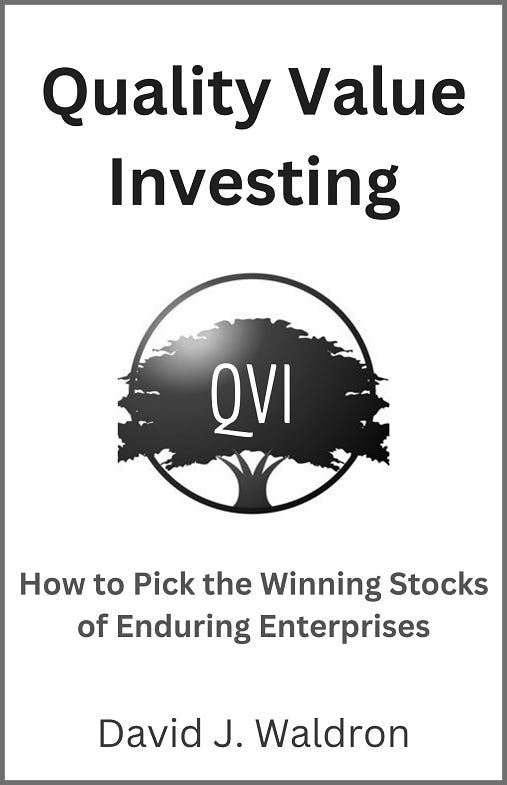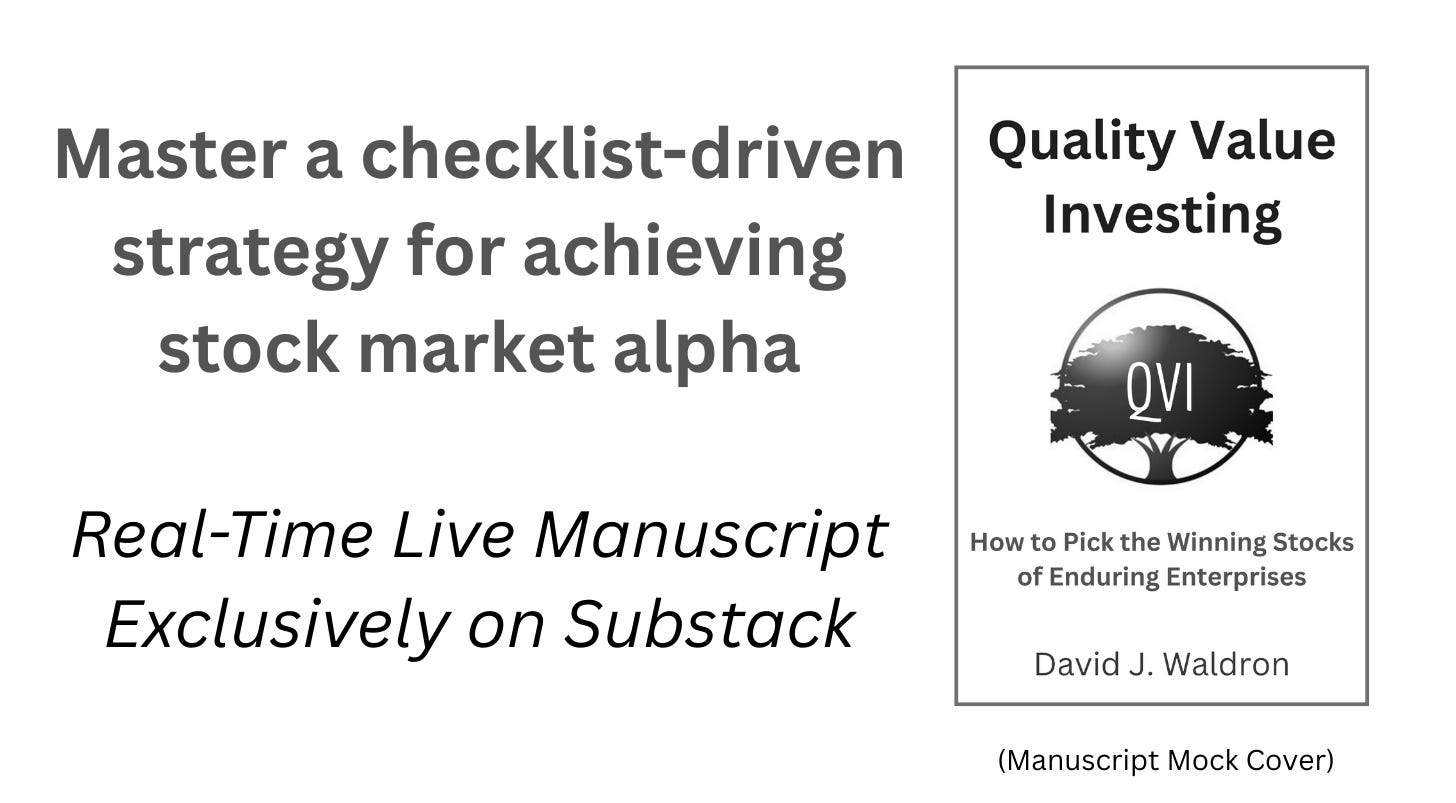Appendix II: Glossary of Investment Terms
Real-time final draft manuscript | Quality Value Investing: How to Pick the Winning Stocks of Enduring Enterprises
Audio voiceover:
Substack’s AI-generated voiceover is available from Books by David J. Waldron. To access it, open the chapter in the Substack app. Feel free to share your thoughts in the comments or via direct message. I will use AI to clone my voice for the book’s official audiobook release.
Learn more about audio voiceovers:
https://davidjwaldronbooks.substack.com/p/audio
Haven’t read the previous chapters? Find them here on the book’s webpages.
Books by DJW Page:
https://davidjwaldronbooks.substack.com/p/quality-value-investing
QVI Page:
https://davidjwaldron.substack.com/p/quality-value-investing-upcoming
Appendix II
Glossary of Investment Terms
Appendix II serves as a reference guide to key investment terms for quality-oriented value investors, listed in alphabetical order.
A
Alpha is the excess return of an investment above what would be expected based on its perceived risk level. It also refers to whether a stock or investment’s total return outperforms the market benchmark, such as the S&P 500.
B
Basis Points, or bps, is a standard unit for measuring percentages in finance. One basis point equals one-hundredth of a percent.
Bearish View is an unfavorable outlook on a company, its share price, an industry, sector, or market.
Behavioral Investing utilizes cognitive traits such as rational thinking, discipline, and patience in a quality-focused approach to stock selection and portfolio management.
Benchmark is a standard or metric used to measure the performance of a stock portfolio or other financial instruments over time. Benchmarks evaluate an investment’s performance against the market, peers, or the investor’s minimum goals.
Beta measures a stock’s volatility or systemic risk relative to the overall market. For example, the S&P 500 beta is constant at 1.00.
Bullish View is a positive outlook on a company, its share price, industry, sector, or market.
Business Model is a strategic plan for how a company will generate profits and cash flow. It explains how a business creates its products or services, promotes them, and makes sales.
C
CAGR stands for the compounded annual growth rate of a company's business metrics or a stock's total return.
Capital Allocation involves distributing and investing a company's or investor’s financial resources to boost efficiency and maximize profits. A company’s management or investor aims to allocate capital in a way that creates the most wealth for its shareholders or portfolio.
Cash Flow Margin measures the quality of earnings or operating cash flow as a ratio of trailing sales.
Catalysts involve expected (confirmations) or unexpected (contradictions) events that can speed up or slow down the investment thesis. Quality-focused investors rely less on catalysts as a second opinion on their fact-based analysis, due to the speculative nature of bulls' and bears' statements.
Checklist Investing employs a thorough yet straightforward approach to researching and analyzing a company’s business model and share price value.
Closing Share Price is the last market closing price of one share of stock traded on an exchange as of the report date.
Company Profile briefly explains the enterprise’s business model and its products or services.
Competitive Advantage is a quality or attribute that enables a business to outperform its competitors. Quality-driven investors prefer companies with enduring competitive advantages.
Concentrated Portfolio is an investment strategy where most funds are invested in a few selected securities. This approach results in less diversification and higher risk compared to a broad, diversified portfolio. Concentration can lead to greater potential returns when investments focus on quality assets bought at reasonable prices.
Confirmation Bias is the tendency to interpret new evidence as support for one’s beliefs or theories. Investors often fall victim to confirmation bias when researching and analyzing data and opinions about a company, stock, fund, industry, sector, or market.
Cost Basis is the average amount spent to purchase each share in a stock portfolio.
Current Ratio measures a company’s short-term liquidity or ability to cover short-term debt by dividing current assets by current liabilities for the same period.
Current View of buy/bullish, hold/neutral, or sell/bearish reflects the recommendation for each company and its underlying stock based on an analysis of relevant research indicators, including the value proposition, fundamentals, returns to shareholders, valuation, and downside risks.
Current Wealth examines factual short-term indicators of a company’s business model.
D
Debt-to-Equity is the ratio used to assess a company’s financial leverage. It is calculated by dividing its total liabilities by its shareholder equity. Investors should only be concerned when a company’s debt surpasses its equity.
Disclaimer is a written or audio statement that provides essential information, such as inherent risks, used by investment firms, financial bloggers, and others in roles where investors may seek general advice or investment education.
Disclosure is a written or audio statement about how biased information disclosed about a company and its stock may unduly influence an investor’s decision.
Dividend Yield shows how much a company expects to pay in average dividends over the next twelve months compared to the current share price.
Dividend Yield on the Cost Basis, or YOC, is calculated by dividing the annual dividend payment by the purchase price of the common shares in a portfolio. YOC is counterintuitive to forward high-yield dividend investing, which carries more risk.
Downside Risks refer to the potential asymmetrical risks and rewards associated with a company and its share price, as perceived by individual investors and market observers. Investment risk is often categorized with labels such as high, above average, average, below average, or low. Investors focused on quality usually prefer profiles that are below average or low risk.
Due Diligence is an investor’s independent research and analysis of a publicly traded company and its underlying stock.
E
Earnings Growth measures how much a company’s net income or earnings per share has increased over a specific period. It is usually calculated as a percentage change and helps assess a company’s sustained profitability.
Earnings Per Share, or EPS, is a metric that measures a company’s profitability by indicating how much profit each share of common stock has earned. Calculate EPS by dividing a company’s net income by the total outstanding shares.
Earnings Yield is the inverse of the price-to-earnings ratio (P/E). It shows how much a company earns each year per common share relative to its stock price. Earnings yield is calculated by dividing EPS by the share price.
Economic Moat is the competitive advantage or unique value that a company’s products or services have over others in the same industry. Morningstar is the top authority on research about competitive advantage. Warren Buffett, founder and chairman of Berkshire Hathaway, is credited with coining the term. Alpha-rich investors focus on companies with evident competitive advantages. An investor or analyst can evaluate a company's value proposition using an economic moat classification of wide, narrow, or none.
Emotional Intelligence is the ability to be highly aware of one's own and others' feelings and motivations, to distinguish between various emotions, and to respond appropriately.
Enterprise Value to Operating Earnings, or EV/EBIT, is calculated by adding the market capitalization of the stock to the company’s debt, minority interest, and preferred shares, then subtracting total cash and cash equivalents. It is the ratio of EV divided by earnings before interest and taxes, or EBIT. EV/EBIT helps determine if a stock is overbought (a bearish signal) or oversold (a bullish signal) by the market.
Equity Bond Rate estimates the intrinsic value of a stock's price or the returns to shareholders. It indicates whether a stock justifies the assumed higher risk compared to a perceived safer intermediate-term government security.
F
Free Cash Flow Yield indicates how much free cash flow a company generates per common share relative to the stock price. Free cash flow per share is the cash available after paying operating expenses and capital expenditures, divided by shares outstanding at the end of the most recent fiscal period, expressed as a percentage of the current share price.
Fundamental Analysis involves gathering qualitative and quantitative data that represent a company’s financial health, economic standing, or overall returns resulting from management performance.
G
GAAP stands for generally accepted accounting principles.
Gross Profit Margin is a company’s primary earnings measure after deducting costs, calculated as total sales or revenue minus the cost of goods or services sold, expressed as a percentage.
H
Hedging is an investment strategy that helps reduce financial risk. It involves holding a complementary investment that generally moves in a direction opposite to that of the primary investment. If the main investment declines in value, the hedge offsets or minimizes losses.
I
Index Fund is a mutual fund or exchange-traded fund (ETF) that tracks the performance of a specific market segment by holding either a representative sample or all of the securities in that index. The goal of an index fund is to match the performance of the underlying basket.
Internal Customers include a company’s employees, board members, suppliers, and vendors. External customers include consumers, investors, regulators, and the community.
Intrinsic Value is the perceived or calculated worth of an asset, investment, or company based on fundamental analysis.
Investment Thesis explains why investors or analysts rate the company and stock as buy/bullish, hold/neutral, or sell/bearish, based on the latest research and analysis.
L
Long-Term Debt Coverage measures current assets divided by long-term debt. A favorite of legendary value investor Benjamin Graham, it reveals a company’s ability to meet its debt obligations and indicates balance sheet liquidity.
M
Macroeconomics is the branch of economics that focuses on the structure, performance, behavior, and decision-making of the entire economy.
Margin of Safety is a principle of value investing where an investor buys securities when the market price is below the perceived intrinsic value.
Market Capitalization indicates whether a stock is large-cap, mid-cap, small-cap, or micro-cap. It reflects the total value of a company’s stock, calculated by multiplying the current market price by the total number of outstanding shares.
Microeconomics is the branch of economics that examines decision-making behavior and outcomes within the economy, including individuals, households, and organizations.
MRFY stands for the most recent fiscal year.
N
Net Profit Margin is the percentage of revenues left after paying operating expenses, interest, and taxes, divided by sales for the trailing twelve months. It is also known as NOPAT or net operating profit after taxes.
Neutral View is an unbiased or range-limited perspective on a company and its share price, an industry, sector, or market.
O
Owners’ Earnings serve as a measure of shareholder value, such as the annualized five-year trailing company’s EPS growth combined with dividend rate growth.
P
Payout Ratio is the total dividends paid divided by after-tax earnings. The lower the payout ratio, the safer the dividend is in terms of being covered by earnings or other available capital.
Portfolio is a collection of stocks, funds, or other securities owned by an investor or a fund. A managed portfolio aims to build wealth or meet financial goals over time.
Present Value assesses the short-term factual metrics that determine a stock’s estimated intrinsic worth.
Price-to-Operating Cash Flow Ratio (P/OCF) is calculated by dividing the previous closing stock price by the cash flow from operations per share for the most recent fiscal year. P/OCF compares the stock price to operating cash flows before capital expenditures.
Price-to-Sales Ratio, or P/S multiple, is calculated by dividing the stock's closing price by the total sales per share over the past 12 months. It indicates how the stock price compares to net revenue.
Price-to-Trailing Earnings Ratio (P/E) is the closing stock price divided by the sum of GAAP diluted earnings per share over the trailing twelve months. P/E is the inverse of the earnings yield.
Products and Services are the company’s core offerings, whether tangible goods or intangible services.
Publicly Traded Company is a corporation whose shareholders have a claim to part of the company’s assets and profits. It is organized through common or preferred stock shares and is intended to be freely traded on a stock exchange or in over-the-counter markets.
Q
Quality Value Investing is an investment strategy that combines value investing principles with a focus on high-quality companies. It can be called ‘quality at a reasonable price (QARP).’ It serves as the value investing equivalent to the once-popular GARP strategy, also known as ‘growth at a reasonable price.’
R
Return on Equity (ROE) is the net income available to common shareholders over the past twelve months, divided by the average total equity from the most recent and previous fiscal periods, shown as a percentage. It indicates how much profit a company makes relative to its shareholder investment in the stock. Board-approved share repurchase programs typically boost ROE.
Return on Invested Capital (ROIC) is net income after taxes divided by the average of total equity plus the sum of total long-term debt, other liabilities, deferred income tax, and minority interest, expressed as a percentage. ROIC indicates how effectively a company uses its capital resources to generate excess returns.
Revenue Growth is the compounded annual growth rate of revenues or net sales over a specific period, expressed as a percentage.
S
S&P 500 Index is a proprietary stock market index that tracks the performance of the 500+ largest companies by market capitalization listed on major stock exchanges in the United States.
Shareholder Equity represents the assets remaining in a business after paying all liabilities with surplus assets. To determine shareholder equity, subtract total liabilities from total assets. Negative shareholder equity occurs when total liabilities exceed total assets on the balance sheet.
Short Interest as a Percentage of the Float shows the proportion of shares that investors have borrowed to sell short and have not yet covered. This short interest serves as a sentiment indicator of whether the market expects a stock's price to decline.
Stock Profile describes a public company’s ticker symbol and categorizes it as a large, mid, small, or micro-cap stock traded on major or over-the-counter exchanges.
Stock Split occurs when a company increases — or sometimes decreases, in a reverse split — the number of shares to improve the stock’s liquidity. Although the number of outstanding shares increases by a specific multiple, the total dollar value of all shares remains the same because a split does not fundamentally alter the company’s value.
T
Ten-Year Treasury Note is a debt security issued by the United States government with a maturity of 10 years from the issuance date. The current yield is the fixed interest payment to the bondholder divided by the note's closing price.
Ticker is the stock symbol or abbreviation for a public company’s shares on a major or over-the-counter exchange.
Total Return is the overall percentage increase from an investment, including capital gains and dividends earned, adjusted for stock splits and other relevant events.
Total Return Performance charts a stock’s historical performance compared to its industry, sector, or broader market benchmarks.
TTM stands for trailing twelve months.
U
US Securities and Exchange Commission, or SEC, is a federal agency that regulates the public equity markets in the United States.
V
Valuation is the process of investment research that involves finding stocks trading below their intrinsic value, which provides a margin of safety. The method compares the current stock price to the company’s actual worth, calculated using specific valuation techniques.
Value Proposition is the competitive advantage that a company’s products or services provide to its customers compared to those of the industry, sector, or marketplace.
W
Watchlist is a listing of assets, such as stocks, bonds, funds, or indexes, that an investor monitors to observe their fundamentals and prices for potential purchase or addition.
Weighted Average Cost of Capital, or WACC, represents the company's overall cost of capital, accounting for each component in proportion to its relative weight. A WACC calculation encompasses all sources of capital, including common stock, preferred stock, bonds, and other long-term debt. ROIC should surpass the WACC by a comfortable margin to demonstrate management’s ability to outperform its capital costs.
Y
YoY stands for year-over-year growth rates.
Next in Quality Value Investing | Appendix III: QVI Newsletter on Substack | Acknowledgements | About the Author
Appendix II: Glossary of Investment Terms is copyright 2025 by David J. Waldron. All rights reserved worldwide.
Universal links allow you to preview or purchase David’s published print, audio, or ebooks — each available globally at your preferred online bookstores — with one or two clicks, brought to you by our trusted partner, BookFunnel.
Share the author’s website, Books by David J. Waldron, with your network to earn credits for a premium subscription that offers full-text and audio access to all of David’s manuscripts and updated chapters of his published self-help books.







